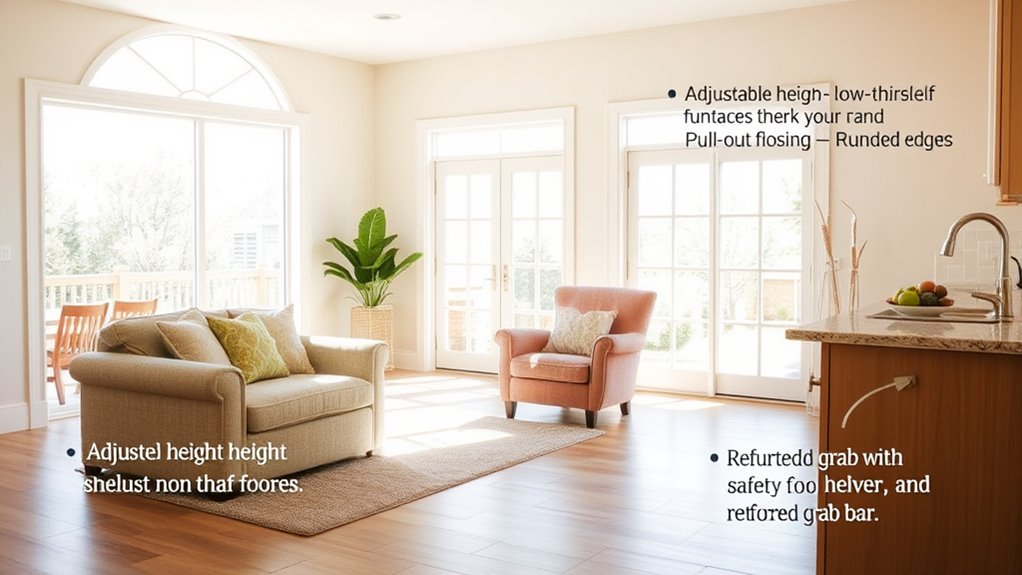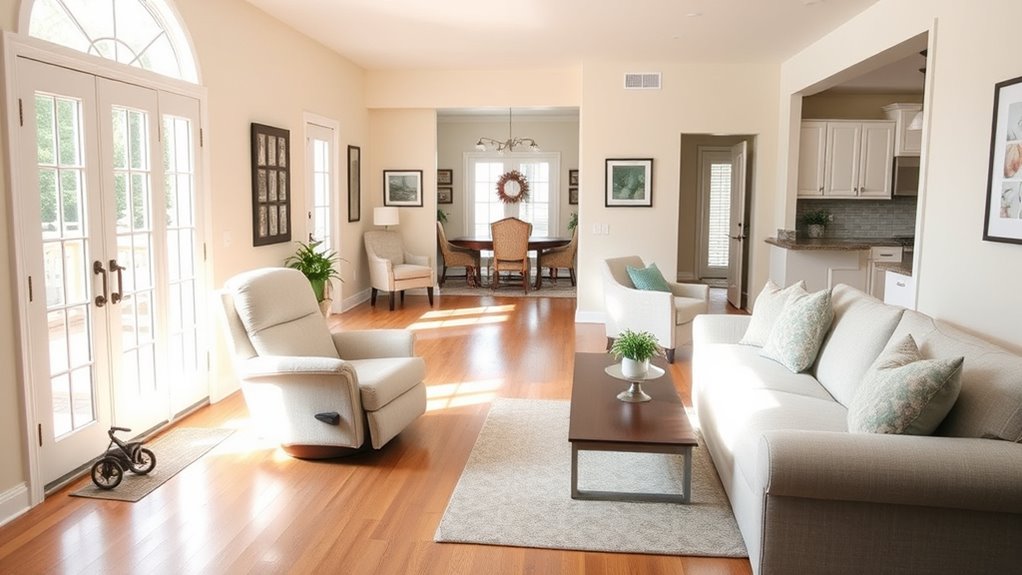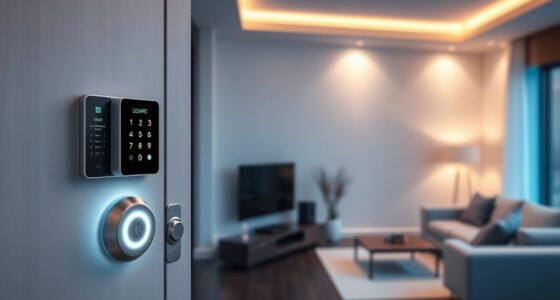To design an accessible home for aging in place, incorporate smart technology that simplifies daily tasks, like voice-activated controls and automated lighting, and add outdoor features such as ramps and slip-resistant pathways. Safety enhancements like grab bars, widened doorways, and improved lighting reduce fall risks. Environmental elements like calming colors and well-maintained landscaping support emotional well-being. Keep evolving your plans to guarantee long-term comfort and independence—exploring how all these elements work together will help you create a truly supportive home.
Key Takeaways
- Incorporate universal design features like widened doorways and low-threshold entryways for easy mobility.
- Install smart technology such as voice-activated assistants and automated lighting to enhance safety and independence.
- Add safety modifications including grab bars, handrails, and slip-resistant pathways to prevent falls.
- Ensure outdoor accessibility with ramps, proper lighting, and landscaped pathways to support safe outdoor activities.
- Plan for future needs by selecting adaptable fixtures and monitoring systems to accommodate evolving mobility and health requirements.

As you plan for the future, designing your home to be accessible can help you maintain independence and safety as you age. Incorporating smart technology is a great way to enhance your home’s accessibility, making daily tasks easier and more manageable. Smart home devices, such as voice-activated assistants, can control lighting, thermostats, and even door locks, reducing the need to move around unnecessarily. Automated lighting systems can turn on when you enter a room and turn off when you leave, preventing falls and conserving energy. Smart sensors can alert you to potential hazards like leaks or unusual activity, providing peace of mind. These technologies work seamlessly together, allowing you to monitor and control your environment from anywhere, which is especially useful if mobility becomes an issue. Understanding how aura colors reflect emotional and spiritual states can also promote a calming environment conducive to well-being.
Outdoor accessibility is equally important in designing an aging-friendly home. You want your outdoor space to be safe, inviting, and easy to navigate. Installing smooth, slip-resistant pathways and ramps ensures you can access your yard or garden comfortably, without worrying about uneven surfaces or stairs. Consider widening doorways or adding low-threshold entry points to make it easier to enter and exit your home with mobility aids like walkers or wheelchairs. Adding well-placed lighting along walkways and entrances improves visibility during nighttime, reducing the risk of trips and falls. Landscaping choices should prioritize low-maintenance plants and avoid overgrown shrubs that could obstruct pathways or create hazards. These adjustments not only boost safety but also allow you to enjoy outdoor activities, fresh air, and nature comfortably, regardless of physical limitations.
Incorporating outdoor accessibility features and smart technology into your home may seem like a significant investment upfront, but they pay off by fostering independence and safety. These modifications create a home environment that adapts to your changing needs over time, reducing reliance on others for daily activities. It’s also wise to think about future-proofing, such as installing grab bars or handrails near entryways and in bathrooms, to further support mobility. By proactively designing with accessibility in mind, you’re setting yourself up for a more comfortable, secure living space that can evolve with you. Making these adjustments now ensures you can enjoy your home long-term, with confidence that your environment promotes safety, convenience, and a sense of independence every day.
Frequently Asked Questions
What Are the Costs Associated With Retrofitting My Home for Aging in Place?
Retrofitting your home for aging in place typically costs between $10,000 and $50,000, depending on your needs. A thorough cost analysis helps you prioritize home safety upgrades like grab bars, ramps, and wider doorways. Expenses vary based on the extent of modifications, materials, and labor. Planning ahead guarantees you stay within budget while creating a safer, more accessible environment for aging comfortably at home.
How Do I Choose the Right Contractor for Accessible Home Modifications?
You should look for a contractor with strong qualifications in accessible home modifications, such as certifications or experience in aging-in-place projects. Ask for references and review their portfolio to guarantee quality work. Discuss the project timeline upfront to set realistic expectations. Choose someone who communicates clearly, respects your needs, and offers transparent pricing. Trust your instincts and prioritize expertise to ensure your home is safe, functional, and tailored for your future needs.
Are There Any Government Grants or Financial Assistance Programs Available?
You can find financial assistance through government grants and programs designed to support accessible home modifications. Check with your local or federal agencies, such as the Department of Housing and Urban Development (HUD) or the Aging and Disability Network, for grants that help cover costs. Additionally, explore state-specific programs and non-profit organizations offering financial aid. These resources make it easier to afford necessary modifications and stay independent in your home.
How Can I Ensure My Home Design Accommodates Future Mobility Changes?
To accommodate future mobility changes, you should plan for features like stairlift installation and bathroom grab bars now. These upgrades make your home safer and easier to navigate as mobility declines. Install wider doorways, eliminate thresholds, and consider non-slip flooring. Regularly assess your needs and consult with accessibility professionals to adapt your space. This proactive approach guarantees your home remains comfortable and secure over time.
What Are the Best Resources for Learning About Aging-Friendly Home Features?
Imagine opening a well-thumbed map that guides you through aging-friendly home features. To start, explore resources on universal design principles from the AARP and the CDC, which act as compasses for safe, inclusive spaces. Conduct safety assessments with local aging agencies or certified professionals to identify specific needs. These tools illuminate your path, helping you craft a home that adapts gracefully to your evolving mobility and safety needs.
Conclusion
As you plan your home for aging in place, remember that thoughtful design can unexpectedly turn everyday spaces into safe havens. Sometimes, the simplest adjustments—like a widened doorway or a no-slip floor—coincide with making life easier and more comfortable. By embracing these small changes now, you might find yourself surprised at how seamlessly independence and ease become part of your daily routine. After all, home is where comfort and safety should always meet.









